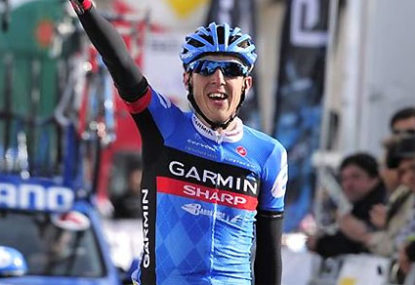'I've just won a stage of the Tour de France, mate!': Hindley grabs yellow jersey as Aussie blows Tour apart
Australia's Jai Hindley has said he is "lost for words" after a shock stage victory at the Tour de France earned him the leader's…

Dressed in tight-fitting lycra and lathered in sweat, I travel as far as I can go along a road heading up into the hills of Townsville, knowing my challenge has not yet been met.
When there’s time for a break, I take a swig of my favourite orange-flavoured electrolytes drink, and continue on.
What sets myself apart from other young fitness warriors is the drive to accomplish new heights of achievement, both on foot and on bicycle.
Achievements often gained through inadequate experience and training, but achievements nonetheless. It’s a game that has become a new way of life.
I strive to meet challenges that the average health addict, runner or cyclist would take months or even years to achieve with normal levels of regular training.
I’m driven by the ability to quantify the work I’ve put in by comparing numbers with other like-minded people through the ‘Facebook’ of the fitness world: Strava.
It’s a Wednesday morning; I wake at 3am and prepare for my morning ritual of a black coffee and a sweet biscuit before I suit up, head-out and start spinning circles.
As I head out, I notice that a Strava user I follow has just beaten my personal best (PB) for a segment of road known as ‘3 Lions’.
It’s not a very popular segment but it’s one that I know I can handle — a 1.4km all-out sprint.
My friend’s results earned him the King of the Mountain (KOM) by completing the segment in two minutes and 21 seconds, with an average speed of 36.1km/h.
To beat this, I knew I would have to warm up extensively.
I plan a nice slow warm-up by riding about 30km before attempting the 3 Lions. I determine the best option was to spin into town and head-up Castle Hill, followed by a nice recovery ride along the Strand before attempting the 3 Lions.
As I approach the 3 Lions, I gear down and start pushing the pedals hard, transferring power into the cranks and then into the wheels.
My speed climbs from 27km/h to 39km/h, a speed I would have to maintain for at least the next two minutes.
When it’s all over just two minutes and 18 seconds later, I realise I’ve won the KOM and will now appear at the top of the Strava’s leader board with an average of 36.9km/h.
After mentally giving myself a pat on the back, I realised my ride wasn’t over yet.
You see, I’m taking part in a cycling mileage challenge and need to maintain my position on the leaderboard.
This particular challenge I’ve joined on Strava requires that I ride 963km in 23 days — an average distance of 41km a day.
However, my mindset is to complete the required distance as fast as possible so I can get back to cross-training in my other fitness area of running.
You see, last the week before the Strava cycling challenge, I was not a cyclist but a champion long-distance runner, with an average pace of six minutes a kilometre.
Though my speed may not be up to that of world-renowned marathon runners, I accomplished running 80 miles, a distance of 128km in 10 days, an average of about 12 km per day.
What makes this even more astonishing, I suppose, is that prior to this I had only run 20km in the week before.
It begs the question, when do you stop?
When do you step back and decide you need to take a break, rather than risk over-training?
The 80-mile running challenge pushed me over the limit. I self-diagnosed shin splints about six days into the challenge, which was probably due to using incorrect running techniques and attempting a half-marathon with a distance of 21km.
But despite my injury, the next day I ran a further 8km, just at a slower than usual pace.
At the end of the challenge I took a few days’ rest and then got straight back into cycling to give my shins some much-needed recovery time.
As I looked back at my achievements in these challenges, I discovered I had lost 1kg in weight, improved on my 5km pace and achieved a new 10km PB. Which can otherwise take weeks to improve with ‘normal training’.
With new social fitness devices being released just about every six months and applications springing up everywhere on smartphones, there’s no doubt about the fact that people love quantifying their fitness in numbers.
Perhaps it’s because, once we have numbers and data to represent the activities we take part in, we can no longer lie to our friends or ourselves about our fitness.
If competing in group challenges isn’t your thing, perhaps setting a personal challenge like walking or running a certain amount of kilometres is.
Walker Alastair Tse who is a member of Quantified Self, a group of people fascinated by taking an interest in self knowledge through self-tracking, has set a goal to walk all of Manhattan.
While others such as Matthew Ames transformed himself through the use of various quantified fitness tools like Nike+ and MyFitnessPal in a bid to lose 40lbs of weight in a year.
As for myself, right now I am happy simply completing challenges and getting my name on the first page of leader boards for certain challenges and segments.
If I can achieve a KOM it’s a bonus.
Tracking my fitness has turned my health into a game that’s as easy or as hard as I want to make it.
I can even inspire my friends to have knowledge through self-tracking their own fitness.
I hope that they too can get meaning out of their personal data.